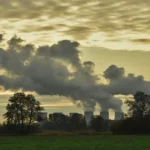Air and water pollution are two major environmental issues that affect our daily lives. Both have severe consequences on our health and the environment. Understanding how these pollutants enter our environment is crucial. It helps us see the serious effects they have on our health and the planet.
The goal here is to shed light on the sources of pollution. By knowing where air and water pollution come from, we can take steps to reduce it. We can also understand the long-term harm it causes to ecosystems and human health.
Furthermore, exploring the impacts of pollution helps us recognize the urgency of addressing these issues. It’s vital to understand the importance of pollution control for a healthier environment and future.
Pollution Definition
Pollution is the introduction of harmful substances into the environment. These substances can come from natural or human-made sources. Pollution affects air, water, and soil, causing harm to living things and the planet. There are different types of pollution.
Air pollution includes harmful gases and particles released into the air. Water pollution happens when chemicals and waste contaminate water bodies. Soil pollution occurs when harmful substances mix with the soil, affecting plant life.
Each type of pollution has serious consequences. However, air and water pollution are among the most damaging. They affect human health, wildlife, and ecosystems. Therefore, it’s important to understand these types of pollution and their impacts.
What Does Air and Water Pollution Mean?
Air Pollution
Air pollution occurs when harmful substances enter the air. These pollutants can be gases, particles, or chemicals. Common sources include vehicle emissions, and industrial waste.
For example, cars and factories release gases like carbon monoxide and sulfur dioxide into the air. These pollutants harm the environment and human health. People exposed to polluted air may suffer from respiratory problems, heart disease, and other health issues.
Water Pollution
Water pollution happens when harmful substances contaminate water bodies. These pollutants can come from chemicals, waste, household wastes, or even natural sources. Common sources include chemical runoff from farms, sewage, and agricultural wastes.
For example, fertilizers and pesticides from farms can wash into rivers and lakes. Sewage and industrial waste can also pollute water bodies, making them unsafe for drinking and harming aquatic life. Water pollution affects not only humans but also animals and plants that depend on clean water.
Difference Between Air and Water Pollution
Air and water pollution are both harmful, but they have different causes and effects. Air pollution occurs when harmful substances enter the atmosphere, while water pollution happens when pollutants contaminate water bodies. The sources of these pollutants also differ.
Air pollution mainly comes from vehicle emissions, industrial smoke, and burning fossil fuels. Water pollution, on the other hand, is often caused by agricultural runoff, industrial waste disposal, and plastic pollution.
The impacts on health and the environment vary as well. Air pollution can cause respiratory problems, heart disease, and even cancer. It also contributes to climate change by increasing greenhouse gases.
Water pollution affects human health by contaminating drinking water, leading to diseases like cholera and dysentery. It also harms aquatic life and disrupts ecosystems. Prevention methods differ too.
Air pollution can be reduced by using cleaner energy sources and stricter emission controls. Water pollution prevention focuses on proper waste disposal, reducing chemical use in agriculture, and treating wastewater.
Also Read: An Informational Guide to Land Pollution
What are the Main Causes of Air Pollution and Water Pollution?
The main causes of air and water pollution stem from various human activities that introduce harmful substances into the environment. Air pollution is primarily caused by industrial emissions, vehicle exhaust, and the burning of fossil fuels. Factories release large amounts of smoke and gases, which pollute the air.
Cars and trucks also contribute by emitting harmful gases like carbon monoxide and nitrogen oxides. Burning coal, oil, and natural gas for energy further adds to the problem by releasing pollutants into the atmosphere.
Water pollution has different causes. Agricultural runoff is a major contributor, where pesticides and fertilizers wash into rivers and lakes. Industrial waste disposal also plays a big role. Factories often dump chemicals and waste into water bodies, contaminating them.
Plastic pollution is another serious issue. Plastic waste ends up in oceans and rivers, harming marine life. Household waste, such as detergents and sewage, also pollutes water sources.
Human activities are the common link between these two types of pollution. Both air and water pollution result from how we produce energy, grow food, and manage waste. Therefore, reducing pollution requires changing these practices.
Using cleaner energy, adopting sustainable farming methods, and improving waste management can help address the root causes of both air and water pollution.
Impacts of Air and Water Pollution
Air and water pollution have severe impacts on human health, ecosystems, and the climate. Pollutants in the air and water create a ripple effect, affecting every aspect of life. These issues harm not only the environment but also contribute to long-term health problems.
Impact on Human Health
Air pollution causes respiratory problems like asthma and bronchitis. Long-term exposure may lead to lung cancer. Water pollution, on the other hand, leads to waterborne diseases such as cholera and dysentery. People living in areas with contaminated water often face higher health risks.
Impact on Ecosystems
Air pollution harms plants and animals by contaminating the soil and water they rely on. Water pollution, especially from chemicals, damages aquatic life. Fish and other marine species suffer from toxic environments, leading to biodiversity loss.
Impact on the Climate
Air pollution contributes to global warming by increasing greenhouse gas levels. Carbon dioxide and methane trap heat, causing temperature rises. Water pollution, especially from waste and chemicals, disrupts ecosystems, making them less resilient to climate change.
Prevention of Air and Water Pollution
Preventing air and water pollution is essential for the health of both people and the environment. Efforts to reduce pollution involve changes in energy use, waste management, and government policies.
Preventing Air Pollution
Renewable energy sources like wind and solar power reduce air pollution. Stricter emission standards for industries and vehicles can also help lower harmful gases released into the air.
Preventing Water Pollution
Treating wastewater before it enters rivers and lakes is crucial. Reducing plastic use, proper management of household waste, and managing agricultural runoff are also key ways to prevent water pollution.
Role of Policy and Individual Actions
Governments play an important role by enforcing environmental regulations. Communities can help by organizing clean-up efforts, while individuals can reduce pollution by recycling, using less plastic, and conserving water.
Role of Public and Government Agencies
The public plays a crucial role in reducing air and water pollution. Small everyday actions can make a big difference. For example, individuals can reduce air pollution by using public transport, cycling, or walking instead of driving. People can also lower water pollution by disposing of waste properly and using less plastic.
Reducing the use of chemicals in household cleaning and gardening can prevent harmful runoff into water sources. Furthermore, raising awareness in communities encourages others to adopt eco-friendly practices.
The government’s role is equally important in tackling pollution. Governments can create policies that limit harmful emissions and promote the use of renewable energy. Laws enforcing stricter standards for industrial waste disposal can significantly reduce water pollution.
Besides, public awareness campaigns can educate people about the dangers of pollution and encourage environmentally-friendly practices. Strong government action and cooperation from the public are key to preventing further pollution.
Conclusion
Addressing air and water pollution is essential for a healthier environment and future. By understanding the air and water pollution causes and impacts, we can take steps to reduce them. Both the public and government have important roles to play.
Small actions by individuals, combined with strong policies, can lead to significant change. Everyone must do their part to limit pollution.
It is important to act now, protect our health, and preserve the planet for future generations. Together, we can make a difference in reducing pollution and safeguarding our environment.






